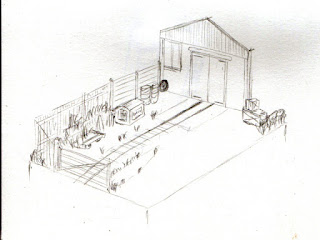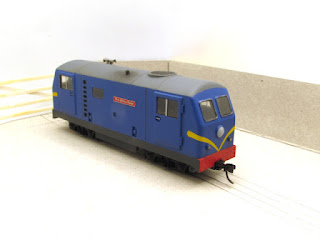As I have mentioned when describing recent changes to my diorama The Headshunt I have been trying to create a new photographic diorama that can be used within a small (12" x 12") lightbox. There have been a couple of false starts to say the least, however the work carried out on the older diorama has created a renewed interest in getting the job done...
I had conducted a little experiment with one of my 70mm deep scenes, just to see how it would work on camera, and in all honesty with a bit more depth it could work. However what this shot does highlight is how any such scene needs to have a fairly solid back piece (wall/fence/hedge) to really work, and the problem of how to treat the area where the track goes off the edge of the scene.
The sketch reveals a host of background junk, and how by leaving the front third of each side clear, maximum camera angles are available in a small space of 8" x 6". In order to try out the idea I built a quick mock-up in the medium of cereal box and double-sided tape and placed it in the light box to try a few photo angles.
Generally speaking the concept worked, and a few trial shots resulted from different angles with a couple of locos used for the test shots. The grey and white makes balancing the images rather fun but that would not be an issue with a fully-developed scene. There is also the possibility of adding a temporary backscene piece behind the wall rather than relying on the lightbox.
There was a slight concern though, one that is not so apparent in the picture above... Although the lightbox kicks out an impressive amount of light, the further forward an item is the more the foreground starts to get into shadow. So when I used a slightly larger loco in the box, the front end isn't quite as well lit as the rear. I had encountered a similar issue on a couple of occasions that I had used 'The Headshunt' in the box end-on (not the greatest of ideas!).
The downside to this idea is that it does away with the workshop building, but it then occurred to me that there is actually a possibility of doing the 45 degree cut at just one end and having the best of both ideas...
Colin






No comments:
Post a Comment